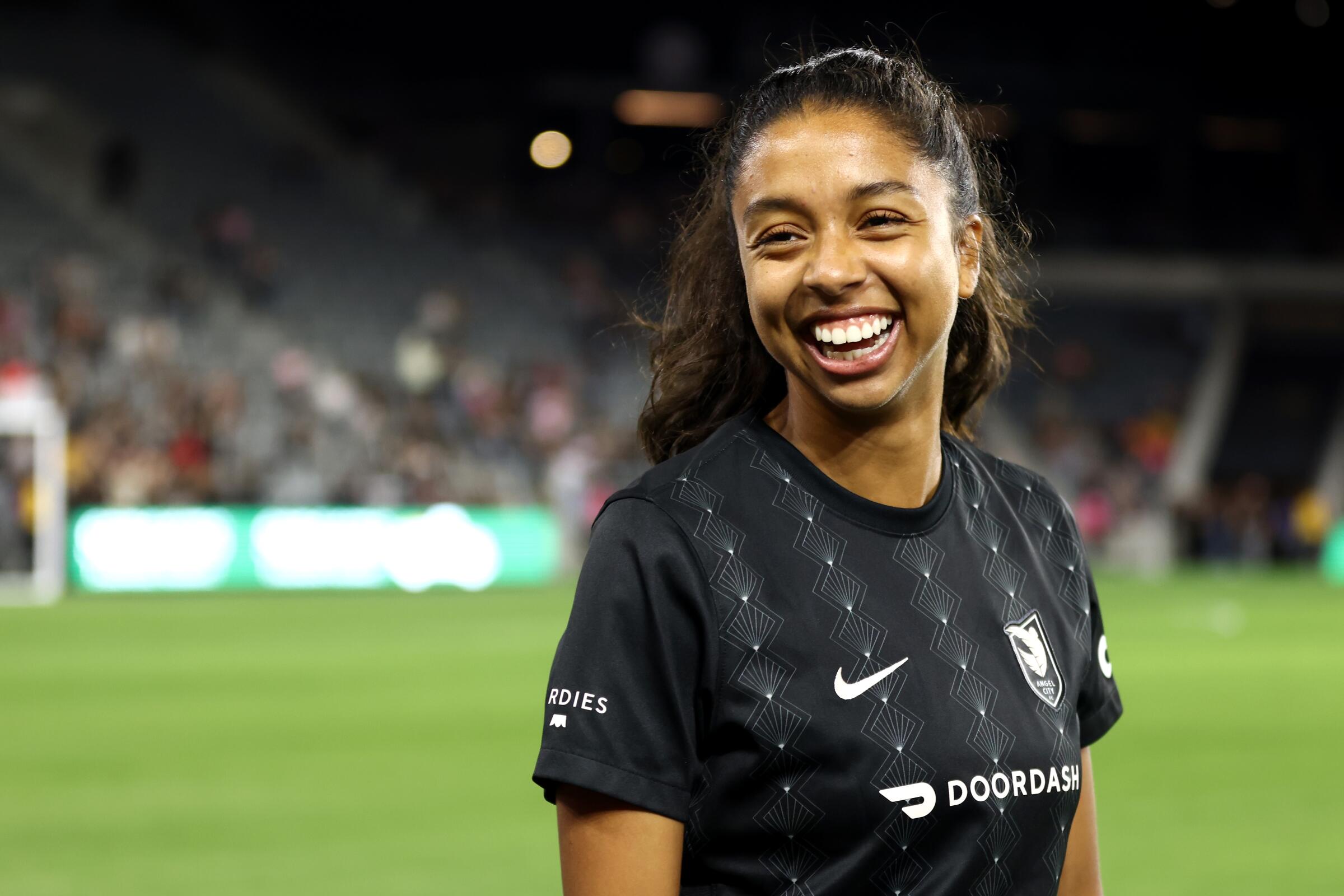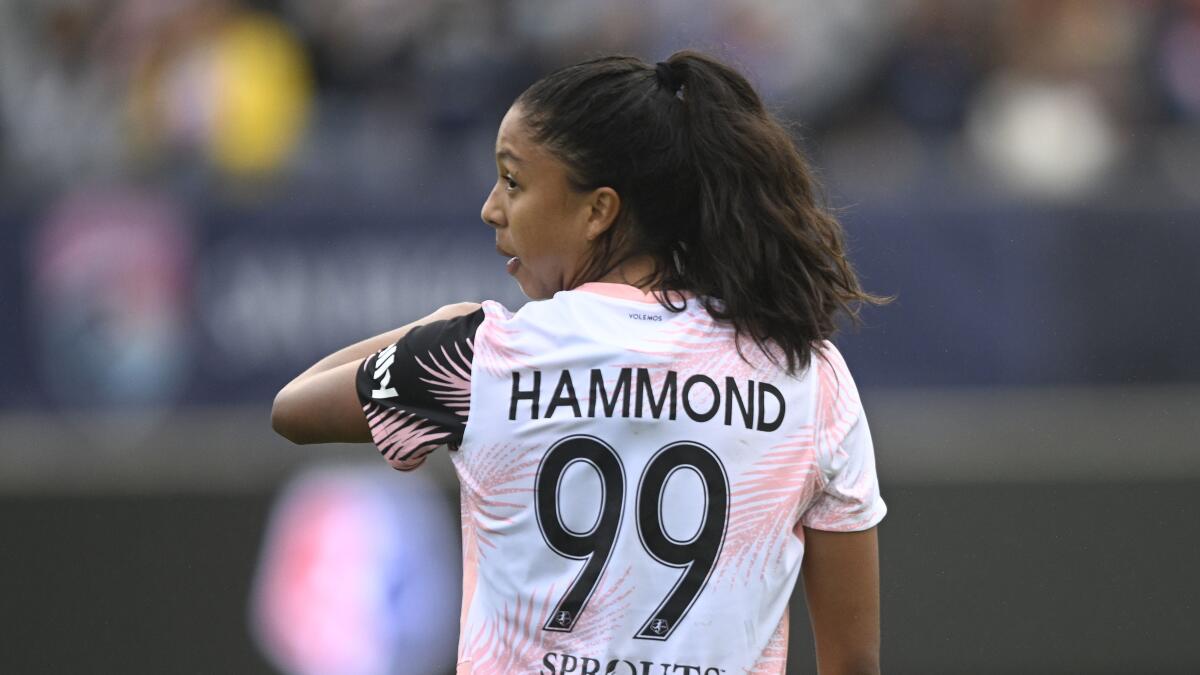Go beyond the scoreboard
Get the latest on L.A.'s teams in the daily Sports Report newsletter.
You may occasionally receive promotional content from the Los Angeles Times.

Madison Hammond didn’t set out to be a trailblazer. Yet when she found herself on that path, she didn’t turn back.
“I just try to do me as best as I can,” the Angel City midfielder said. “But I have become, for lack of a better term, an inspiration to a lot of kids.”
Though she says that humbly, there’s certainly a lot about Hammond that qualifies as inspiring. She was a four-year starter at Wake Forest, where she also played the violin in the school orchestra, made the Atlantic Coast Conference’s all-academic team four times and was a member of the National Honor Society as well as separate honor societies in Spanish, science and history.

And all that happened before she became a professional soccer player, which is where the other inspirational thing comes in. When Hammond played her way onto the OL Reign as a non-roster invitee in 2020, she became the first Native American in NWSL history — and an influence for others who, like many in her family, grew up on a reservation.
“I didn’t even know I was the first native player in the NWSL. I’m just Madison,” said Hammond, who is Navajo, San Felipe and Black. Although she grew up in New Mexico, she moved with her mother Carol Lincoln, who works with the U.S. Public Health Service, to Virginia when she was in the fifth grade, leaving much of her family behind in the southwest. And while she has long understood and appreciated her background, it’s only recently that she’s come to appreciate what it means to others.
“I met with a girl from the Navajo nation after [a] game and she was just so excited to see me,” Hammond said. “I don’t take myself that seriously, but I gave her my jersey and to see how much it clearly meant to her, that kind of shifts your perspective on what sport can do for young people and young people of all backgrounds.
“So even to have a small platform in that, I’m really grateful for.”
Angel City star Alyssa Thompson is among a group of emerging teenage stars who are poised to change development standards for U.S. women’s soccer players.
That small platform just got a little bigger with the release of “Katishtya Girl,” a mini-documentary that follows Hammond from Los Angeles back to her family in the San Felipe Pueblo — Katishtya, in the native language spoken by her Pueblo family members — 25 miles north of Albuquerque. In the 5-minute 26-second film, released last month and available on YouTube, Hammond talks about her start in soccer as a 5-year-old who was soon playing on boys’ teams and the stress of being the first native player.
“There’s been doubt and everything, but she’s overcome that and I’m just incredibly proud to see what she means to the community,” said Lincoln, who raised Hammond as a single mother. “The great thing about being an American Indian is the communities, they embrace you.”
In the documentary Hammond also speaks about the mental challenges she struggled with last season after being traded from the OL Reign, where she was a starting center back, to Angel City, where she played just 321 regular-season minutes.

“Last year was very tough,” she said. “I learned a lot about myself as an athlete, but also as a person. It’s the first time in my life really experiencing things like anxiety, especially related to sports performance.”
Hammond, 25, started the first four games of the preseason Challenge Cup and three of the first six regular-season games, but she played just 22 minutes the rest of the year. And when she did play, the pressure to avoid mistakes was all-consuming.

Her mind began to wander. Would people think she was a fraud? That she was on the team only because of her background and not her talent?
“I was raised to rub dirt in it,” she said. “You grind through it. I always thought going to therapy, talking about mental health, made you weak.
“But then I found a really good therapist and I’ve truly changed in so many different ways. I can give myself a lot more grace to make mistakes and to fail. It’s not going to be the end of the world.”
Two-time World Cup champion Julie Ertz, who stepped away from soccer to give birth to her son, has signed a one-year contract with Angel City.
That new mentality could be tested this year, one that began with Hammond changing positions, going from the back line to the midfield, and appearing in each of Angel City’s first eight matches. And though she played her best game of the season during Sunday’s 3-2 win over the Kansas City Current, which stopped a five-game winless streak, she could be forced back to the bench by the team’s signing of two-time World Cup winner Julie Ertz.
“It’s adding competition in the midfield. That, I think, raises everyone’s performance,” was coach Freya Coombe’s diplomatic summation.
Hammond isn’t the first athlete in her family to blaze trails. Her uncle Notah Begay III, among the first Native Americans to compete on the PGA Tour, played golf with Tiger Woods at Stanford and against him as a pro.
“He’s done a lot for our community,” Hammond said of Begay, who established a foundation that uses soccer and golf to provide health and wellness education to Native American youth. “It’s very nice to be able to call him and ask for advice, especially because he understands the sport side and what it takes mentally feeling imposter syndrome, feeling just different sometime, but ultimately wanting to compete and wanting it to be about your craft.
“That’s sometimes the disconnect that other people don’t always understand. So it’s nice to have that in house and family.”
Also like her uncle, Hammond hopes her influence in her community doesn’t end when her soccer career does.
“Sports is something that … there’s a time limit,” said Hammond, who frequently starts sentences, pauses, then backtracks to make sure she’s chosen the right words. “There’s a clock on it. I can be fully committed to sports now but career No. 2, career No. 3 could look completely different.
“And then I’ll just bust those doors down when I get there.”
The point, she said, is to have an impact, no matter where and how it comes. Because being the first Native American to bust through those doors means nothing if no one follows you.
⚽ You have read the latest installment of On Soccer with Kevin Baxter. The weekly column takes you behind the scenes and shines a spotlight on unique stories. Look for it every Tuesday morning at latimes.com/soccer. Listen to Baxter on this week’s episode of the Corner of the Galaxy podcast.
Go beyond the scoreboard
Get the latest on L.A.'s teams in the daily Sports Report newsletter.
You may occasionally receive promotional content from the Los Angeles Times.